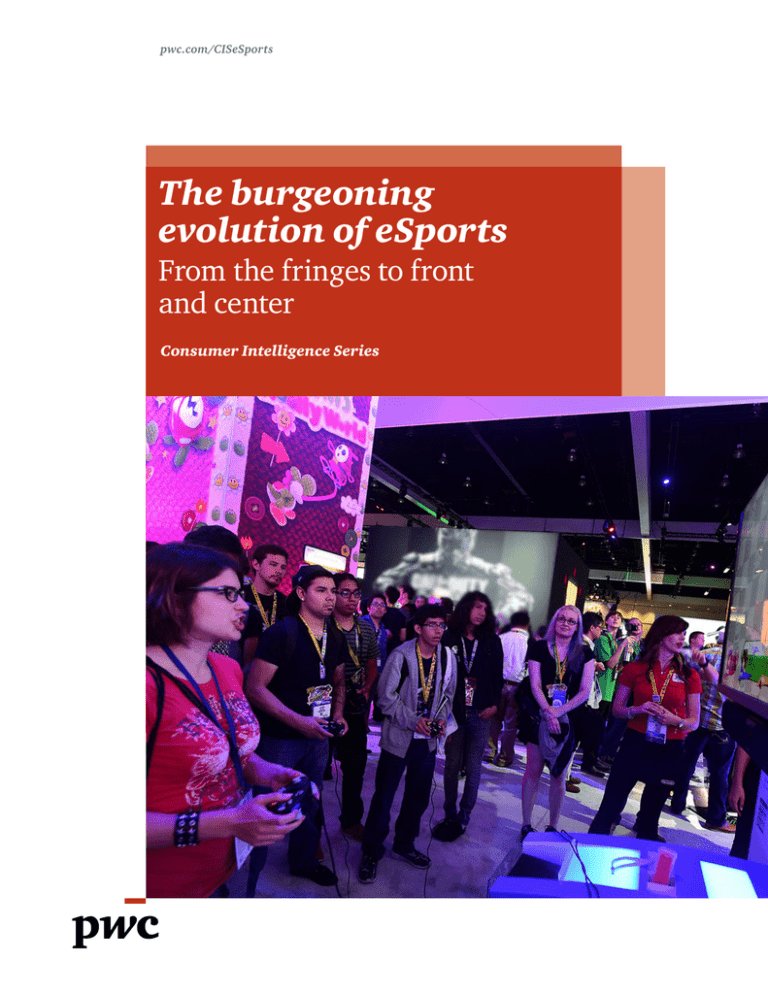
pwc.com/CISeSports
The burgeoning
evolution of eSports
From the fringes to front
and center
Consumer Intelligence Series
What is
eSports?
Competitive gaming has been around
almost as long as video games
themselves. Initially, much of the
competition centered around friends
challenging each other in a game of
Pinball. But this quickly transitioned
to organized tournaments beyond just
arcade games. The Space Invaders
Championship held by Atari in 1980
was the first large-scale video game
competition, attracting more than
10,000 participants across the United
States.1 This tournament, and the
others that have followed, set the
stage for what would ultimately
become eSports.
Some four decades later, has eSports
finally reached its tipping point? We
believe so.
For this survey, we defined eSports as
organized video game competitions
involving, for example, fighting (e.g.,
Mortal Kombat), first-person shooter
(e.g., Call of Duty), multiplayer online
battle arena (MOBA) tournaments
(e.g., League of Legends), or massively
multiplayer online (MMO) games
(e.g., World of Warcraft).
1
igital Spy, “Gaming Like a Pro: An Overview of the
D
eSports Scene,” February 5, 2012.
Shaking off the
social stigma
The not-so-secret
community
A negative stigma has long been
associated with the act of playing video
games: enthusiasts lack maturity,
motivation, sociability. Telling someone
you spent the weekend slaving over
your gaming console would make it
seem as though you’d sat alone in a
basement for three days partaking in
a slightly shameful activity. Yet, a slow
but steady shift has occurred over the
years, pushing the act of gaming closer
towards acceptance.
Social media has arguably been
the most powerful catalyst for the
mainstreaming of eSports. The chatter
started small in online forums, but this
medium was stunted by fragmentation
and limited availability. It wasn’t until
the world became more connected—
via the Internet and social media—
that the gaming community could
unite and flourish. Through Twitter
and Facebook, gaming enthusiasts
were finally unified and could
interact with one another seamlessly,
while remaining anonymously if
they preferred.
In the early 2000’s, the free-to-play
model made gaming more accessible,
which in turn delivered increased
interest from consumers and
publishers. With more people playing,
the gaming giants had the incentive to
invest in more entertainment. Pile on
the inventions of streaming and social
media, and you have a tipping point of
awareness and legitimization.
Highest awareness of eSports:
57%
34%
Enter Twitch in 2011 and eSports
finally had a home. Purchased for
nearly $1 billion by Amazon in 2014—
to shock and awe from media outlets
everywhere—Twitch helped transform
eSports from the ugly stepchild to
the star quarterback. Billing itself as
the first and largest social network
for video game fans, Twitch.tv is the
epicenter of the gaming movement we
see today. Last year alone, according
to Twitch, its users streamed 241
billion minutes of video—or 459,000
years’ worth.
“eSports is another
genre that can’t be
easily dismissed as
an underground
‘niche,’ or a mere
subset of the gaming
genre.”
– Chad Gutstein, CEO of
Machinima
Self-identified
hardcore gamers
18-24 year olds
Base: Total respondents when accounting for full sample before quota terminations
(n=2105); Q11. Are you aware of/have you heard of the term “eSports”?
PwC | The burgeoning evolution of eSports | 1
From ugly stepchild to
star quarterback
Today, social media remains the
mainstay for eSports chatter. Twitter,
RedditNews, blogs, and forums have
all been created specifically to cover
the competition, with topics ranging
from game play to Q&As with eSports’
most sought-after celebrities.
And much like the industry itself, the
growth in conversation about eSports
is increasing steadily. During our
3-month social listening campaign, we
uncovered a total of 278,000 mentions
of eSports. November 2015 yielded
fewer than 5,000 mentions. A scant
two months later—by January 2016—
that number had spiked ninefold to
more than 45,000 (driven in large
part by ESPN’s announcement of a
dedicated eSports vertical on TV).
Conversation took place mainly on
Twitter, with a small but significant
portion on forums.
From trendy to mainstream
eSports is big . . . and getting bigger.
After years of slow and steady growth
under the radar, we now have a
phenomenon the country can no
longer ignore or question. The game’s
stardom continues to reach new
heights. Below are just a few of its most
recent notable accomplishments:
• August 2013: The League of
Legends Finals live competition sells
out LA’s Staples Center to more than
10,000 spectators
• September 2014: A small private
university in Chicago—Robert
Morris University—begins offering
scholarships to videogame players.
• Early 2016: Turner Sports
president Lenny Daniels says the
network will cover eSports “just
like it covers traditional sports like
Major League Baseball, the NBA,
and the NCAA Final Four.”2
• January 2016: ESPN launches a
specific eSports vertical.
• January 2016: Turner Sports
officially enters the eSports arena
at the Consumer Electronics Show
“An important characteristic of eSports is
the combination of its Asian roots moving
into North America and Europe with their
installed infrastructure of consoles and
enthusiastic base of video gamers. Just like
social media, it’s a global phenomenon
without borders.”
– David Stern, former commissioner of the National Basketball Association
• March 2016: Yahoo! Inc.
announces the launch of
Yahoo eSports, a “new premier
destination for delivering
professional eSports coverage
across major games and events,
coupled with a comprehensive
product experience.”3
A global movement
eSports’ roots can be traced back
to South Korea, which pioneered
the space and has one of the most
established eSports organizations to
date. It’s taken the world some time to
catch up, but now that it has, we can
expect massive growth in involvement
and profitability. Says David Stern,
former commissioner of the National
Basketball Association, “An important
characteristic of eSports is the
combination of its Asian roots moving
into North America and Europe
with their installed infrastructure of
consoles and enthusiastic base of video
gamers. Just like social media, it’s a
global phenomenon without borders.”
The global eSports economy continues
to surge ahead, with revenue expected
to hit $463 million this year—a 43%
jump from 2015.4
The US is leading this global market
with a 38% share of revenues,
according to figures from research
firm Newzoo.5 Company CEO Peter
Warman forecasts the US will maintain
its lead and generate $175 million in
eSports revenue this year from online
advertising, sponsorships, media
rights, merchandise, tickets, and
additional publisher investment.
2
Fortune, Here’s why eSports is coming soon to a TV near you,” September 28, 2015.
3
Yahoo press release, “Yahoo Launches New Experience Dedicated to Esports,” March 2, 2016.
4, 5
2 | The burgeoning evolution of eSports | PwC
(CES) with a $50,000 “CS:GO”
tournament that feeds into a $2.4
million prize pool for 2016.
Newzoo, “2016 Global Esports Market Report,” January 25, 2016.
“The rise of social media,
live streaming, and
expanded distribution
options for broadcasts
of top level competition
have enabled eSports to
break down geographical
barriers in a way that
many traditional sports
have struggled with.”
– Mike Sepso, Senior Vice President of
Activision Blizzard Media Networks
A new world: growing
up gaming
Growing pains: is eSports
even a sport?
Today, kids are being born into a world
where playing video games can be
as strategic as a quantitative math
problem. As the competition continues
to attract more attention and money, it
is moving out of the shadows, landing
squarely front and center for new
generations of enthusiasts.
The gaming community has fought
long and hard for legitimacy in the
sports world. Take, for example,
ESPN’s recent investment in eSports.
While many fans were excited about
the national platform, equally as many
X Games fans claimed that eSports,
while competitive, are not legitimate
sports or “action sports.” Despite the
controversy among the community,
ESPN moved forward with its decision.
July 2015 saw the launch of a new
Gen Y-focused live-action sitcom
from Disney XD: Gamer’s Guide to
Pretty Much Everything. The show
follows a young boy named Conor,
a professional video game player
who goes by the name of Kid Fury.
In November 2015, the show was
renewed for a second season.
Says David Stern, former commissioner
of the National Basketball Association,
“Of course it is a ‘sport.’ It fills arenas
and stadia, has an OTT network built
on it (Twitch), and there is a robust
market in team purchases that seems
to be developing.”
Blaine Graboyes, CEO of eSports
arcade machine maker GameCo,
agrees. “There’s no question that
eSports is a ‘sport’ in the same sense as
football or baseball. eSports viewership
exceeds top traditional sporting events
such as the World Series and NBA
Final. eSports athletes are receiving
the same visa and drug testing as
traditional athletes. Sports stars such
as Shaq and A-Rod are investing in
eSports. A decade from now eSports
will have continued its growth and be
on par with today’s traditional sports.”
The eSports community recognizes they
have a long road ahead: to continue
educating the public on why their sport
is indeed, a real sport. It’s entirely
possible, though, that the growth or
success of eSports won’t be tied to
whether or not it’s acknowledged as a
sport, but rather whether the eSports
value pool is on par with traditional
sports and other sectors.
All the angst and uncertainty
notwithstanding, eSports has already
proven itself a worthy competitor. It’s
here to stay.
PwC | The burgeoning evolution of eSports | 3
Survey overview and
study objectives
Through PwC’s ongoing Consumer
Intelligence Series, we gain directional
insights on consumer attitudes and
behaviors in the rapidly changing
media and technology landscape. This
report summarizes key findings from a
757-respondent survey6 conducted in
March 2016. The goal of this research
was to study the eSports landscape.
Specific objectives were to explore:
• Overall awareness level of eSports
• Who the eSports consumer is and
how they are interacting with
the sport
• Frequency of eSports interaction
and the change year-over-year (past
and future)
• Types of gaming content
that’s winning over the
eSports community
• Motivators behind eSports
viewership and participation
• Monetary implications derived
from eSports
• Likelihood of future eSports
involvement among current nonconsumers and deterrents/barriers
to doing so
6
Demographics—56% male, 44% female
19% of sample: 18-24 years old
44% of sample: 25-34 years old
24% of sample: 35-49 years old
13% of sample: 50-64 years old
Census representation for ethnicity and race.
4 | The burgeoning evolution of eSports | PwC
How do we define eSports in
this survey?
What clarifies as an “eSport” is still in
question; even those entrenched in the
industry dispute various definitions
and parameters. For this survey,
we defined eSports as: Organized
video game competitions involving,
for example, fighting (e.g., Mortal
Kombat), first-person shooter (e.g.,
Call of Duty), multiplayer online battle
arena (MOBA) tournaments (e.g.,
League of Legends), or massively
multiplayer online (MMO) games
(e.g., World of Warcraft).
“Someone who puts
in hours of practice
a day, competes
against the best
in the world, and
has to endure
the pressure of a
massive fanbase
dissecting their
strategy certainly
deserves the title of
‘athlete’ to me.”
– Brian Selander, EVP of
Whistle Sports
Key findings
“A decade from now
eSports will be on
par with today’s
traditional sports.”
– CEO of eSports arcade machine
maker, GameCo, Inc.
The growth of eSports
Becoming a household name
• Total awareness jumped to 30% after a definition of eSports was given.
• Overall awareness was notably higher, unaided and aided, among millennials
and those who identified themselves as hardcore gamers.
Do you know what eSports is?
Unaided, 15% of our survey respondents were aware of eSports.
34%
15%
Total
respondents
25%
7%
P18-24 P25-34 P35+
14%
14%
Caucasian/ African
White
American
18%
Asian
57%
23%
Hispanic/
Latino
Hardcore
gamer
Base: Total respondents when accounting for full sample before quota terminations
(n=2105); Q11. Are you aware of/have you heard of the term “eSports”?
How did you first learn about eSports?
Word-of-mouth was the primary awareness driver for all eSports consumers. It was
also the highest source of awareness for self-identified casual and new gamers.
For hardcore gamers, however, they first learned about eSports from online
gaming communities and other online user-generated sites (e.g. reddit).
Watcher, players, or both
20% of those surveyed are involved with eSports as watchers, players, or both.
No involvement
No involvement
80%
Involvement
Watch only
12%
Watch &
participate
6%
Participate only
2%
Base: Total respondents when accounting for full sample before quota terminations
(n=2105); Q13. Have you ever watched and/or participated in an eSports event/
competition?
PwC | The burgeoning evolution of eSports | 5
What does the eSports consumer look like?
eSports
Consumer
vs
Non-eSports
Consumer
• Gender neutral
• Gender neutral
• Median age: 28
• Median age: 34
• 69% P18-34
• 55% P18-34
• Racially diverse
• Skews white
• More likely to own various tech devices (desktop
computer, connected TV, connected device, etc.)
• Much less active on social media
• Spends more time in front of screens, whether gaming
or streaming video content
• Less likely to invest in sports (i.e. buying tickets to a
Football game)
• Much less likely to play fantasy sports
A woman’s game, too
22% of women surveyed say they’re involved with eSports
vs. 18% of men. While this difference is relatively small, it
could indicate an early trend that women are just as, if not
more engaged with eSports than their male counterparts.
“For success in
eSports, it’s critical to
recognize that today’s
‘average’ gamer is
not the stereotype of
a male teen in their
parents’ basement.”
– Cinnamon Booth, COO of
GameCo, Inc.
6 | The burgeoning evolution of eSports | PwC
The eSports viewer
Viewership on the rise
• Among total eSports viewers, 1 in 5 watch weekly.
• The eSports consumer averages 19 days of viewing per year.
• Asian and Hispanic viewers tend to watch more frequently (27 days and 23
days, respectively).
• Self-identified hardcore gamers watch most of all (averaging 32 days per year).
Is viewership up vs. a year ago?
36%
More
45%
Same
19%
Less
Base: Total eSports viewers (n=373); Q16. How does
the amount of eSports you currently watch compare
to how much you watched a year ago?
Traditional devices—laptop and desktop computers—win the game
• 5
7% of respondents who have watched an eSports competition have done so
on a laptop or desktop computer. This is more than any other device, making
traditional computers the preferred method of viewership.
• Laptop and desktop computers are even more popular among Asians (79%),
18-24 year olds (73%) and males (67%).
• Gaming consoles are being used more frequently among females (60%) and
hardcore gamers (56%).
Desktop or laptop computer
Gaming console
Television
Smartphone
Tablet
In-person (live event)
57%
26%
46%
24%
32%
12%
Base: Total eSports viewers (n=373); Q17. From the list below, please tell us how/
where you’ve watched eSports gaming/competitions (select all that apply).
PwC | The burgeoning evolution of eSports | 7
First-person shooter
rocks content
• First-person shooter games are the
#1 watched genre in eSports among
viewers, regardless of age, gender, or
type of gamer.
• Multiplayer online battle arena
competitions run a close second
for 18-24 year olds (47%), who are
significantly more likely to watch
the genre more than any other
age bracket.
Boom, Boom, Pow!
63%
37%
36%
First person shooter
Multiplayer online
battle arena
Fighting
28%
5%
Massively multiplayer
online games
Other
Base: Total eSports viewers (n=373); Q18. Which of the below eSports genres do you
usually watch?
Men like competition; women enjoy social interaction
• We see some of the biggest gender differences here. Men appear to be watching eSports from a competitive lens—they not
only enjoy watching their favorite games being played at the highest level, but they also watch competitions to improve
their own game.
• Women, on the other hand, appear to watch for enjoyment—they truly enjoy watching the game and the social aspect that
comes along with the competitions.
Why watch eSports?
30%
20%
10%
0%
I enjoy watching
my favorite
games being
played at the
highest level
I enjoy watching
competitions
I learn ways to
get better at the
video game I
like playing
I am interested
in the game
My friends are
I get to watch the I can follow all of
watching/I feel
best players in
my favorite
comfortable with the world
players
the eSports
community
Total eSports viewers
Male
Female
P18-24
P25-34
Base: Total eSports viewers (n=373), Male eSports viewers (n=217), Women eSports viewers (n=156), P18-24 eSports viewers
(n=89), P25-34 eSports viewers (n=169); Q23. From the list of reasons below, please select the ONE that best describes why you
watch eSports gaming/competitions.
8 | The burgeoning evolution of eSports | PwC
The eSports player
Total eSports players
Almost half play once per month
• Among total eSports players, nearly half (42%) are playing at least once
per month.
• Respondents spend slightly less time per year participating in eSports events
(17.5 days) than watching them (19 days).
70%
At home only
18%
In person at
• Directionally, men are playing slightly more often than women.
In-home competitions rule the day
• Playing in one’s home versus in person at an event is more convenient,
especially for those players living in small towns or in areas where live games
are not easily accessible. So it’s not surprising that in-home competitions are
most prevalent.
• Home also provides a safe space for new eSports gamers, or those players
who are shy; eSports players who classify themselves as casual or new gamers
overwhelmingly choose home as their only location to play (79%).
• Directionally, self-identified hardcore gamers are most likely to play outside
the home, with 60% saying they’ve played in person at a live event.
First-person shooter games win again
a live event
12%
Both at home
and in person
at a live event
Base: Total eSports players (n=170); Q33.
Have you participated in eSports gaming
competitions at home, in person at a live
event, or both?
• e Sports competitors overwhelmingly play first-person shooter games more than
any other type of game (62%).
• T
he similarities between the types of games played and those watched end
there, however:
Gaming genres
100%
80%
60%
Play
Watch
62% 63%
48%
36%
40%
31%
28%
28%
37%
20%
0%
First-person
shooter
Fighting
Massively
multiplayer online
games (MMO)
Multiplayer
online battle
arena (MOBA)
Base: Total eSports players (n=170), Total eSports viewers (n=373); Q35. Which of the
below genres have you participated in? Please select all that apply.
PwC | The burgeoning evolution of eSports | 9
The eSports consumer
Average $ spent on gaming/year
eSports consumers spend more overall
• S
urvey respondents spend, on average, $245 on video
games per year—this includes but is not limited to the
purchase of consoles, games, accessories, subscriptions
and events.
• T
he eSports consumer, however, spends more—their
annual spending, on average, tops $300.
Total
respondents
Non-eSports
consumers
eSports
consumers
$245
$163
$309
Base: Total respondents (n=757), eSports Gamers [ever engaged with eSports] (n=418), Non-eSports gamers (n=339); Q10. How much
do you estimate you spend per year on video games (including consoles, games, accessories, DLC, subscriptions, events, etc.)? If you
do not pay but someone else pays for you, please count that as well.
The business of eSports
Who’s playing the game?
With competitive gaming seeing rapid,
triple-digit growth, opportunities
abound—and companies industrywide are taking notice. Agencies,
advertisers, live event companies and
sporting venues are just some of the
businesses aligning with eSports.
The appeal to investors surpasses the
game itself, relying heavily on the
passionate audience who’s watching.
On Twitch.tv, an estimated 70% of all
viewers are under the age of 35—our
sample mirrored this, at 68% under
the age of 35 among those who have
ever watched a competitive game. Not
only is this age bracket appealing, but
it’s become harder and harder to reach
millennials on traditional platforms like
linear television. Moreover, TV viewers
can sometimes be passive; eSports
viewers tend to be highly engaged.
10 | The burgeoning evolution of eSports | PwC
So who’s entered the partnership
arena with eSports? Players, teams
and leagues make up the bulk of the
current investment pie, but it won’t be
long before we see further expansion
into non-traditional partnerships.
Below is a small snapshot of the
eSports partnership playing field:
• Agencies: Agencies are clamoring
to represent players and leagues as
sponsorship money continues to
skyrocket.
• Brands: Consumer beverages,
finance companies, auto
manufacturers, the list goes on.
Brands are sponsoring and/or
partnering with players, leagues,
teams, and more.
• Fantasy: Traditional fantasy
sporting companies are betting on
eSports, allowing consumers to bet
on the competitive game much like
they would any other sport.
• Hardware: More attention and
money is being paid to creating
gaming equipment (think:
controllers, keyboards, etc.) that is
specifically designed for eSports.
• Linear: Television networks are
beginning to broadcast eSports on
the big screen.
• Mobile: Mobile apps are popping
up to provide fans with news, stats,
and live scoring coverage.
• Publishers: Gaming companies
continue to acquire, partner,
innovate and create in the space.
• Tech: Tech companies are
backing eSports in more ways
than one; recently, a well-known
company signed on for a long-term
deal to provide demonstrations
and product sales at numerous
eSporting events.
• VR: Much attention is being paid
to the convergence of eSports
and virtual reality; venture
capitalists agree this marks huge
growth potential.
Is eSports poised for digital domination?
Most of the companies investing in eSports are forming digital partnerships;
the streaming of eSports represents a market ripe with value.
And opportunity: Nearly one out of every five (18%) of our respondents
who has watched an eSports competition has paid a subscription fee to do so.
Additionally, consider these numbers:
• 334 million—the total cumulative daily unique impressions of the League of
Legends 2015 World Championships (up from 288 million in 2014).
• 421.6 minutes—the amount of programming minutes gamers view per
month on Twitch.tv (far higher than YouTube’s 291 monthly minutes).7
The digital world is an eSports ally that will continue to surge upwards.
Companies looking to join the fray should find their niche while the competition
is still segmented enough to enter.
Spotlight: Live events
The gaming industry always pushes the boundaries of what’s deemed
“entertainment,” so live events are a natural progression for this growing
competition and its cult fan base. Some might think that eSports may still have
to prove themselves in this space—while gaming competitions have been around
for decades selling out a live arena still sounds far-fetched. However, eSporting
events have passed the proof-of-concept phase and entered the big leagues.
The signs of success are clear:
Decision drivers for attending
an event
Most important drivers
23%
16%
• More than 70 million people watch competitive gaming (that’s 10 million
more than the population of the UK).8
• Riot’s League of Legends tournament in 2014 sold out Seoul’s second-largest
arena (a stadium that once hosted the 2002 FIFA World Cup).
11%
Panel discussion
Time of year
Price
VIP Tickets
Base: Total respondents (n=757), eSports Gamers [ever engaged with eSports] (n=418),
Non-eSports gamers (n=339); Q10. How much do you estimate you spend per year on
video games (including consoles, games, accessories, DLC, subscriptions, events, etc.)?
If you do not pay but someone else pays for you, please count that as well.
Genre
• More people watched the League of Legends championships in 2015 than the
World Series or the NBA finals.9
Location
• Prizes for winning tournaments are nudging $10 million+.
11% 11%
14%
Least important drivers
7
echCrunch, “Twitch’s Users Watch More Video In a
T
Month, On Average, Than Typical YouTube Users Do,”
February 11, 2016.
SuperData, “The worldwide eSports market reaches
134 million viewers,” May 4, 2015.
8
9
SPN, “‘League of Legends’ ratings top NBA Finals,
E
World Series clinchers,” December 3, 2014.
PwC | The burgeoning evolution of eSports | 11
The future of eSports
Interest in eSports among current consumers will
remain strong
• The majority of current eSports consumers will
either increase or maintain their level of involvement
in the coming year, both in viewership (83%) and
participation (72%).
Base: Total eSports viewers (n=373), total eSports players
(n=170); Q16. How does the amount of eSports you currently
watch/play compare to how much you watched/played a year
ago and how much you intend to watch/play in the future?
Can I just watch?
• More respondents who are not currently involved with
eSports are interested in watching a gaming competition
in the future (one-third) than in participating (26%) in a
competition.
• Lack of interest is heavily tied to content, either to watch
or play. Lack of awareness appears to be another huge
barrier, but that’s changing.
Base: Respondents not currently involved with eSports
(n=339); Q38. How would you rate your level of interest in
watching and/or participating in the future?; Q39. Please select
up to three reasons from the below that best describe why
you are not that interested in watching and/or participating in
eSports competitions.
How does current eSports behavior compare to
future intent?
Participate
Watch
26%
More
29%
More
57%
Same
17%
Les
43%
Same
28%
Less
Top 3 reasons behind lack of future interest
Barriers to view
I’m not interested
in the games
they’re playing
I was not aware of
eSports before
this survey
I’m not aware when/
where the broadcasts
are taking place
62%
32%
23%
Barriers to participate
I’m not interested
in the games
they’re playing
I was not aware of
eSports before
this survey
I don’t think I’m good
enough/don’t think I
can win
12 | The burgeoning evolution of eSports | PwC
54%
35%
32%
Implications
1. The eSports consumer
represents a vast source
of untapped potential for
companies to build relationships
and market new products. Seen
as not-quite-mainstream for many
years, these fans—male and
female—are passionate, loyal, and
willing to spend money on what
they enjoy.
2. Though growing, overall
awareness is still low. A third
of our survey respondents said
they didn’t watch or participate
in eSports because they were
unaware of its existence,
representing another vast
untapped source, this time of
potential future customers. Going
beyond major cities to smaller
markets might well yield a new
customer base. As could new
games. Look beyond the typical
gamer to those who know nothing
about eSports today. Showcase
eSports as a new source of
entertainment.
3. The mystique surrounding
eSports sometimes intimidates
new and beginner players
who don’t think they’re good
enough to participate. Offer a
variety of levels and the ability to
play anonymously.
4. eSports is a market ripe with
value, especially digitally.
Though growing, live events
still represent a small piece of
the eSports pie. Given location
restrictions and other limitations,
live attendance will require
demand to be aggregated from
wide geography, which will place
pressure on admission fees. For
now, save live events for premium
content—championships vs.
league play. To scale, focus should
be placed on digital distribution,
which is a platform that can scale
quickly with demand.
5. eSports fandom and loyalty
are heavily tied to the content
itself, unlike traditional sports
where fans tend to follow
specific teams or players.
What game is being played
vs. who is playing. Consider
this notion when marketing or
sponsoring tournaments.
6. Revenue opportunities abound,
from online advertising and
sponsorships to media rights,
merchandise, tickets, and
additional publisher investment
(money invested by publishers that
is not recouped directly through its
eSports activities). It’s time to take
the plunge.
PwC | The burgeoning evolution of eSports | 13
pwc.com/CISeSports
For more information on this
research, the PwC Consumer
Intelligence Series, or how digital
transformation is shaping
the entertainment and media
industries, please contact one of
our specialists:
Deborah Bothun
deborah.k.bothun@pwc.com
(616) 471 9048
Matthew Lieberman
matthew.lieberman@pwc.com
(213) 217 3326
Additional information is also available on:
pwc.com/cis
© 2016 PwC. All rights reserved. PwC refers to the US member firm or one of its subsidiaries or affiliates, and may sometimes refer to the PwC network. Each member firm is a
separate legal entity. Please see www.pwc.com/structure for further details.
155522-2016. Rr.








